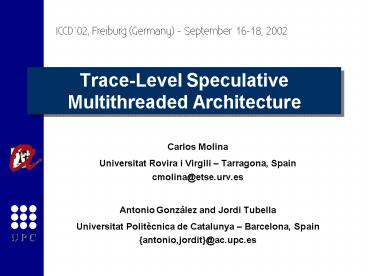TraceLevel Speculative Multithreaded Architecture PowerPoint PPT Presentation
Title: TraceLevel Speculative Multithreaded Architecture
1
Trace-Level Speculative Multithreaded Architecture
ICCD02, Freiburg (Germany) - September 16-18,
2002
- Carlos Molina
- Universitat Rovira i Virgili Tarragona,
Spaincmolina_at_etse.urv.es - Antonio González and Jordi Tubella
- Universitat Politècnica de Catalunya Barcelona,
Spain antonio,jordit_at_ac.upc.es
2
Outline
- Motivation
- Related Work
- TSMA
- Performance Results
- Conclusions
3
Motivation
- Two techniques to avoid serialization caused by
data dependences - Data Value Speculation
- Data Value Reuse
- Speculation predicts values based on past
- Reuse is posible if has been done in the past
- Both may be considered at two levels
- Instruction Level
- Trace Level
4
Trace Level Reuse
- Set of instructions can be skipped in a row
- These instructions do not need to be fetched
- Live input test is not easy to handle
5
Trace Level Speculation
- Solves live input test
- Introduces penalties due to misspeculations
- Two orthogonal issues
- microarchitecture support for trace speculation
- control and data speculation techniques
- prediction of initial and final points
- prediction of live output values
6
Trace Level Speculation with Live Input Test
ST
NST
Miss Trace Speculation Detection Recovery
Actions
7
Trace Level Speculation with Live Output Test
ST
NST
Miss Trace Speculation Detection Recovery
Actions
8
Related Work
- Trace Level Reuse
- Basic blocks (Huang and Lilja, 99)
- General traces (González et al, 99)
- Traces with compiler support (Connors and Hwu,
99) - Trace Level Speculation
- DIVA (Austin, 99)
- Slipstream processors (Rotenberg et al, 99)
- Pre-execution (Sohi et al, 01)
- Precomputation (Shen et al, 01)
- Nearby and distant ILP (Balasubramonian et al,
01)
9
TSMA
Look Ahead Buffer
10
Trace Speculation Engine
- Two issues may handle
- to implement a trace level predictor
- to communicate trace speculation opportunity
- Trace level predictor
- PC-indexed table with N entries
- Each entry contains
- live output values
- final program counter of trace
- Trace speculation communication
- INI_TRACE instruction
- Additional MOVE instrucions
11
Look Ahead Buffer
- First-input first-output queue
- Stores instructions executed by ST
- The fields of each entry are
- Program Counter
- Operation Type indicates memory operation
- Source register Id 1 source value 1
- Source register Id 2 source value 2
- Destination register Id destination value
- Memory address
12
Verification Engine
- Validates speculated instructions
- Mantains the non-speculative state
- Consumes instructions from LAB
- Test is performed as follows
- testing source values of Is with non-speculative
state - if matching, destination value of I may be
updated - memory operations check effective address
- store instructions update memory, rest update
registers - Hardware required is minimal
13
Thread Synchronization
- Handles trace misspredictions
- Recovery actions involved are
- Instruction execution is stopped
- ST structures are emptied (IW,LSQ,ROB,LAB)
- Speculative cache and ST register file are
invalidated - Two types of synchronization
- Total (Occurs when NST is not executing
instructions) - Penalty due to fill again the pipeline
- Partial (Occurs when NST is executing
instructions) - No penalty
- NST takes the role of ST
14
Memory Subsystem
- Mantains memory state
- speculative
- non speculative
15
Register File
- Slight modification to permit prompt execution
- Register map table contains for each entry
- Commited Value
- ROB Tag
- Counter
- Counter field is mantained as follows
- New ST instruction increases dest. register
counter - Counter is decreased when ST instruction is
commited - After trace speculation counter are no longer
increased - But it is decreased until reaches the value zero.
16
Working Example
ST
NST
VE
17
Experimental Framework
- Simulator
- Alpha version of the SimpleScalar Toolset
- Benchmarks
- Spec95
- Maximum Optimization Level
- DEC C F77 compilers with -non_shared -O5
- Statistics Collected for 125 million instructions
- Skipping initializations
18
Base Microarchitecture
19
TSMA Additional Stuctures
20
Performance Evaluation
- Main objective
- trace misspeculations cause minor penalties
- Traces are built following a simple rule
- from backward branch to backward branch
- minimum and maximum size of 8 and 64 respectively
- Simple Trace Predictor is evaluated
- Stride Context Value (history of 9)
- Results provided
- Percentage of misspeculations
- Percentage of predicted instructions
- Speedup
21
Misspeculations
100 90 80 70 60 50 40 30 20 10 0
22
Predicted Instructions
50 40 30 20 10 0
23
Speedup
1.35
1.30
1.25
1.20
1.15
1.10
1.05
1.00
24
Conclusions
- TSMA
- designed to exploit trace-level speculation
- Special emphasis on
- minimizing misspeculation penalties
- Results show
- architecture is tolerant to misspeculations
- speedup of 16 with a predictor that misses 70
25
Future Work
- Agressive trave level predictors
- bigger traces
- better value predictors
- Generalization to multiple threads
- cascade execution
- Mixing prediction execution
- speculated traces do not need to be fully
speculated

